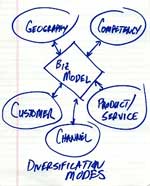While business plans are a must in this environment, the startup world can hardly be considered predictable. Companies like Flickr, Seemic and Redux were all launched with different original concepts. Nevertheless, the market embraced the new products and each of these companies has done well in carving out a niche. But not every 180 degree shift can be successful, ReadWriteWeb looks at one theory on how to reduce risk while changing focus.

VP of Diamond Consultants John Sviokla recently wrote a Harvard Business Review piece entitled, “Is This Innovation Too Disruptive for My Firm?” In it Sviokla explains how a number of large scale businesses have attempted to diversify into new markets and have failed miserably. He writes, “You need to decide whether the core business will embrace the new product or service or reject it.”
Given last year’s abysmal funding environment and the need for startups to move quickly to keep their businesses cash flow positive, a number of founders shifted product direction with positive results. One great example is when Seesmic CEO Loic Le Meur relaunched his product from a video site to a streaming social service.
In a message to users last June, Le Meur remarked, “I’m an entrepreneur trying to find growth…the context has really changed in the last year and a half and I need to make Seesmic (the company) survive.”
Meanwhile, social entertainment site Redux first launched as a music playlist site but quickly moved towards video sharing when it failed to gain traction in the music space.
Based on Alfred Chandler’s model of market strategy, Sviokla explains that companies should not stray too far from their core proficiencies. He believes that transitioning companies can best diversify their businesses if the new direction matches the current target customer, distribution channel, product/service, geography and competency.
Says Sviokla, “I believe that if the innovation your firm is considering is “close” to current practice on all five of these, it is less risky to implement. If it is different on these five dimensions, it becomes much riskier.” For the entire article visit the Harvard Business Review.










